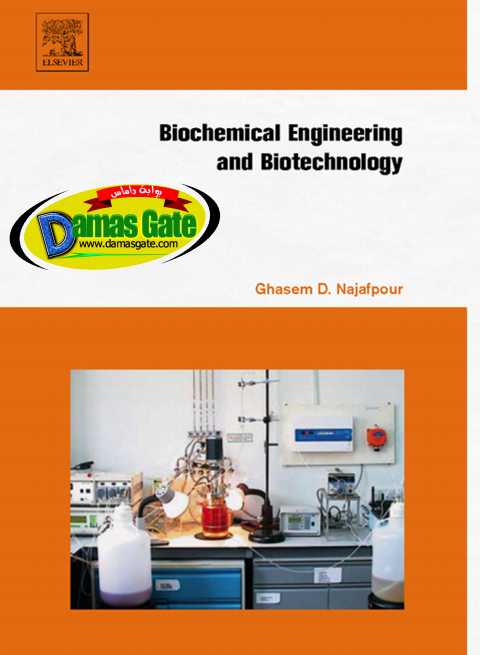Biochemical Engineering and Biotechnology - G.D. Najafpour

Preface
In the new millennium, extensive application of bioprocesses has created an environment
for many engineers to expand knowledge of and interest in biotechnology. Microorganisms
produce alcohols and acetone, which are used in industrial processes. Knowledge related to
industrial microbiology has been revolutionised by the ability of genetically engineered
cells to make many new products. Genetic engineering and gene mounting has been developed
in the enhancement of industrial fermentation. Finally,
application of biochemical
engineering in biotechnology has become a new way of making commercial products.
This book demonstrates the application of biological sciences in engineering with theoretical
and practical aspects. The seventeen chapters give
more understanding of the knowledge related to the specified field,
with more practical approaches and related case studies
with original research data. It is a book for students to follow the sequential lectures with
detailed explanations, and solves the actual problems in the related chapters.
There are many graphs that present actual experimental data, and figures and tables,
along with sufficient explanations. It is a good book for those who are interested in more
advanced research in the field of biotechnology, and a true guide for beginners to practise
and establish advanced research in this field. The book is specifically targeted to serve as a
useful text for college and university students; it is mostly recommended for undergraduate
courses in one or two semesters. It will also prove very useful for research institutes and
postgraduates involved in practical research in biochemical engineering and biotechnology.
This book has suitable biological science applications in biochemical engineering and
the knowledge related to those biological processes. The book is unique, with practical
approaches in the industrial field. I have tried to prepare a suitable textbook by using a
direct approach that should be very useful for students in following the many case studies.
It is unique in having solved problems, examples and demonstrations of detailed experiments,
with simple design equations and required calculations. Several authors have contributed
to enrich the case studies.
During the years of my graduate studies in the USA at the University of Oklahoma and
the University of Arkansas, the late Professor Mark Townsend gave me much knowledge and
assisted me in my academic achievements. I have also had the opportunity to learn many
things from different people, including Professor Starling, Professor C.M. Sliepcevich and
Professor S. Ellaison at the University of Oklahoma. Also, it is a privilege to acknowledge
Professor J.L. Gaddy and Professor Ed Clausen, who assisted me at the University of Arkansas.
I am very thankful for their courage and the guidance they have given me. My vision in
research and my success are due to these two great scholars at the University of Arkansas:
they are always remembered.
Download
http://s18.alxa.net/s18/srvs2/02/003....Najafpour.rar

Preface
In the new millennium, extensive application of bioprocesses has created an environment
for many engineers to expand knowledge of and interest in biotechnology. Microorganisms
produce alcohols and acetone, which are used in industrial processes. Knowledge related to
industrial microbiology has been revolutionised by the ability of genetically engineered
cells to make many new products. Genetic engineering and gene mounting has been developed
in the enhancement of industrial fermentation. Finally,
application of biochemical
engineering in biotechnology has become a new way of making commercial products.
This book demonstrates the application of biological sciences in engineering with theoretical
and practical aspects. The seventeen chapters give
more understanding of the knowledge related to the specified field,
with more practical approaches and related case studies
with original research data. It is a book for students to follow the sequential lectures with
detailed explanations, and solves the actual problems in the related chapters.
There are many graphs that present actual experimental data, and figures and tables,
along with sufficient explanations. It is a good book for those who are interested in more
advanced research in the field of biotechnology, and a true guide for beginners to practise
and establish advanced research in this field. The book is specifically targeted to serve as a
useful text for college and university students; it is mostly recommended for undergraduate
courses in one or two semesters. It will also prove very useful for research institutes and
postgraduates involved in practical research in biochemical engineering and biotechnology.
This book has suitable biological science applications in biochemical engineering and
the knowledge related to those biological processes. The book is unique, with practical
approaches in the industrial field. I have tried to prepare a suitable textbook by using a
direct approach that should be very useful for students in following the many case studies.
It is unique in having solved problems, examples and demonstrations of detailed experiments,
with simple design equations and required calculations. Several authors have contributed
to enrich the case studies.
During the years of my graduate studies in the USA at the University of Oklahoma and
the University of Arkansas, the late Professor Mark Townsend gave me much knowledge and
assisted me in my academic achievements. I have also had the opportunity to learn many
things from different people, including Professor Starling, Professor C.M. Sliepcevich and
Professor S. Ellaison at the University of Oklahoma. Also, it is a privilege to acknowledge
Professor J.L. Gaddy and Professor Ed Clausen, who assisted me at the University of Arkansas.
I am very thankful for their courage and the guidance they have given me. My vision in
research and my success are due to these two great scholars at the University of Arkansas:
they are always remembered.
Download
http://s18.alxa.net/s18/srvs2/02/003....Najafpour.rar